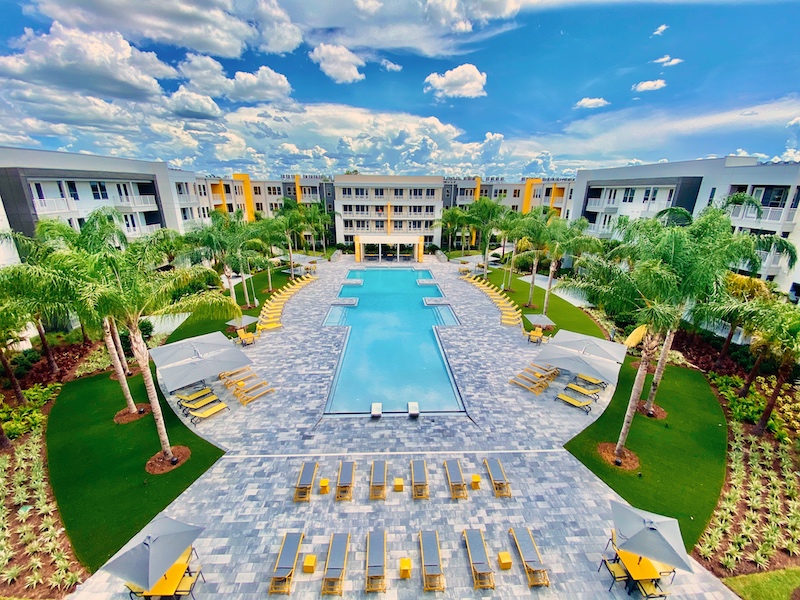The developer TPA Residential recently selected McShane Construction to build Woodward Crossing, a Class-A, 265-unit apartment complex on 7.8 acres in Buford, Ga. The apartments would be inside two buildings, four and five stories, designed by the architecture firm Niles Bolton Associates. Its completion is scheduled for May 2022.
The Southeast is one region of the country where multifamily construction remains steady, according to construction firms active there. “Our core footprint is currently in the Southeast, [where] apartments are performing very well right now,” says Marc Padgett, president of Summit Contracting Group. Demand for multifamily isn’t cooling off, either; Summit had signed contracts for more projects through September 2020 than it had during the same nine months last year. And Padgett expects 2021 to be better for his company than either of the two prior years.
“What many don’t realize is when the economy worsens, the demand for multifamily improves,” he explains.
Last January, the general contractor Brasfield & Gorrie completed Deca Camperdown, a $48 million, 11-story building in Greenville, S.C., with 217 apartments that average 1,007 sf and feature luxury finishes. NELSON Worldwide was the architect, and Daniel Corporation the developer.
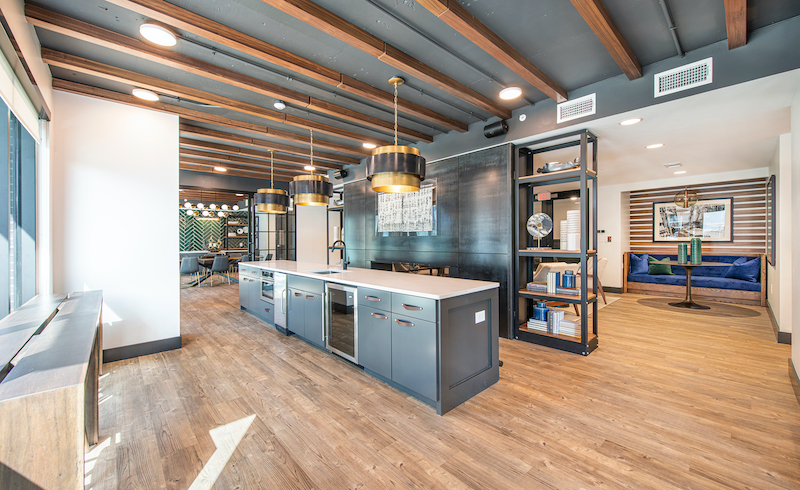
Deca Camperdown in Greenville, S.C., which was completed last January, boasts 217 homes with luxury interior finishes such as quartz countertops, stainless steel appliances, and designer light fixutres. Images: Kevin Ruck, courtesy of Brasfield & Gorrie
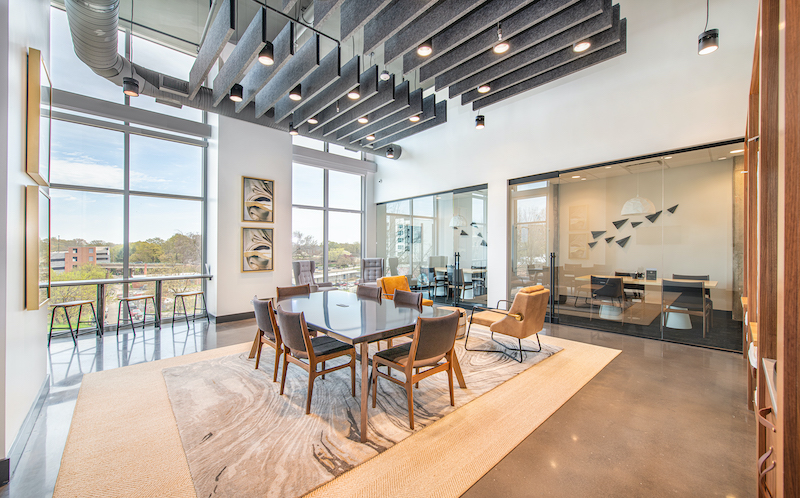
Opportunities for urban infill high rise construction are scarcer, acknowledges Roddy McCrory, Brasfield & Gorrie’s Vice President and Regional Business Development Director. But Alabama-based firm is encouraged by stronger demand for “affordable options”—like garden-style apartments or podium products—that support workforce renters’ needs in cities and suburbs in the Southeast.
PROJECTS PROCEED, DESPITE SOME MARKET SOFTNESS
On a national level, the multifamily sector, which over the past several years gave housing construction its wings, has been coming back to earth. The annualized rate for housing starts in buildings with five more apartments stood at 295,000 units in September, which according to Census Bureau estimates was 17.4% below starts for the same month in 2019. Multifamily permits, a barometer of future building, were also down in September, by 22.2% to 390,000 units.
Also see: Multifamily’s long-term outlook rebounds to pre-COVID levels in Q3
Multifamilybiz.com, citing Dodge Data and Analytics as its source, reported that for the 12 months ending in September, multifamily starts were off 5%, compared to a 7% gain in single-family starts over the same period.
CBRE’s economic advisers predict the multifamily market will reach its bottom in the fourth quarter of 2020 and begin recovering in the first quarter of 2021. Vacancies will rise to 7.2% by the end of 2020, a full 3.1 percentage points higher than what’s projected for the end of 2021.
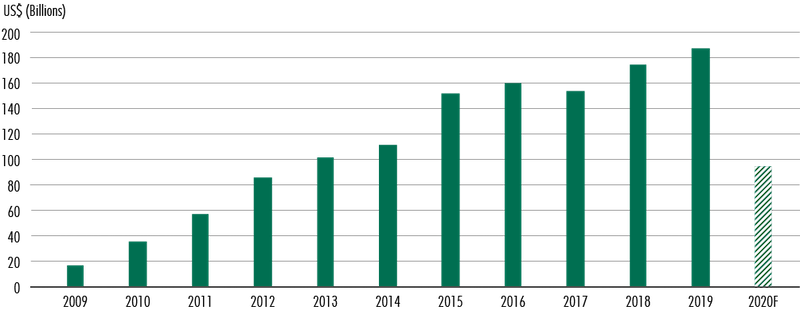
CBRE projects that investment in multifamily properties will be way off this year, but start recovering in 2021. Image: CBRE
This national pullback notwithstanding, large multifamily projects continue to get built, often as centerpieces of ambitious redevelopment plans. Last August, Brasfield & Gorrie completed The Julian, a 14-story 381,000-sf apartment complex in Orlando, Fla., designed for Ustler Development by Baker Barrios Architects, with 409 units and a 10-story 234,000-sf parking garage. The Julian is part of Creative Village, a 68-acre mixed-use transit-oriented urban infill neighborhood.
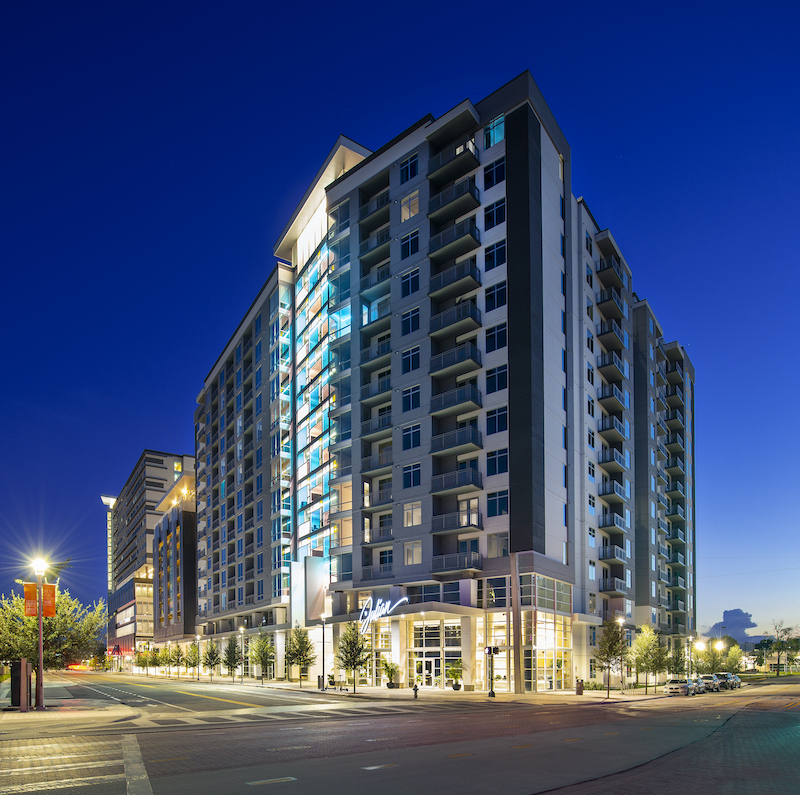
The Julian Apartments are the first housing in Orlando's Creative Village neighborhood development that are not restricted to students of the new downtown University of Central Florida campus. Image: Ben Tanner Photography, courtesy of Brasfield & Gorrie
That same month, ground broke for the $130 million AJ Railyards mixed-use building on 2.89 acres in Sacramento, Calif. (Brown Construction is the GC, LPAS Architects the design architect.) AJ Railyards will have 345 rental apartments (69 of them affordable), and 5,000 sf of ground-floor retail. This project, scheduled for completion in the winter of 2022, is a partnership between LDK Ventures and USA Properties Fund. It is part of a 244-acre urban infill redevelopment that, while still in its early stages, will eventually double the size of downtown Sacramento.
Also see: Miami’s yacht-inspired UNA Residences begins construction
On October 27, Shawmut Design and Construction broke ground on 1.16 acres in Providence, R.I., for Emblem 125, a nearly $90 million development that, when it opens in the summer of 2022, will include 248 residential units, 22,700 sf of ground-floor retail space, and an 1,800-sf rooftop space. This mixed-use building, developed by Exeter Property Group and designed by Torti Gallas + Partners and ZDS, is one of the largest to break ground within the I-195 Redevelopment District. Rhode Island’s Governor Gina Raimondo lauded Emblem 125 as “a huge step forward for the growth of the Providence Innovation and Design District.”
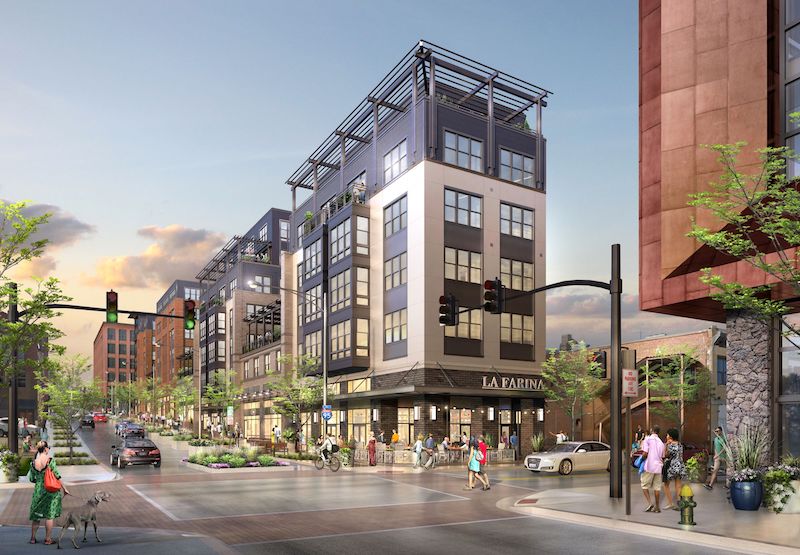
A rendering of Emblem 125, a $90 million multifamily project that will be part of Providence, R.I.'s Innovation and Design District. Image: Exeter Property Group.
COVID-19 RATTLES SUPPLY CHAIN
As was the case for other building types, multifamily supply and demand were hobbled by the spread of the coronavirus. In Freddie Mac’s 2020 Midyear Outlook, Steve Guggenmos, the agency’s Vice President of Research and Marketing, wrote that multifamily demand in the second quarter saw “a meaningful slowdown given the nationwide shutdown,” along with a high rate of lease renewals as tenants stayed put during the height of quarantines and lockdowns. Guggenmos also cited estimates by Reis, a leading commercial real estate data source, that multifamily completions tracked at least 30% lower than pre-pandemic levels through the first half of 2020.
Some market watchers also contend the COVID-19 pandemic drew attention to the country’s chronic housing shortage. And the virus certainly changed behaviors on multifamily jobsites.
Gilbane Building Company is using an artificial intelligence tool on some of its multifamily sites to perform checks on whether people coming to the site are wearing face coverings, and to provide temperature checks. Gilbane was also an early adopter of Proximity Trace, a wearable technology that detects social distancing.
Brasfield & Gorrie has limited the number of workers in its jobsite hoists and elevators, heightened cleaning protocols, and made changes in its break areas and food vendors, says McCrory.
The pandemic has created some supply-chain headaches, especially in the availability and pricing of lumber, says AEC sources. “The biggest impact we are seeing [on multlfamily] is the sourcing of materials for core building components,” says Sean Buck, Vice President-Operations for JE Dunn Construction. He explains that in the high-rise space, products like electrical fixtures, countertops, and casework are typically sourced from various countries. “Given the current COVID and political environment, this poses some procurement risk,” and has led JE Dunn more toward U.S.-based suppliers.
Padgett says Summit Contracting has always strove to buy American, “and right now, 100% made in the U.S.A. is most desirable” to minimize delays in availability and delivery. Padgett adds that “good planning and coordination” can overcome supply-chain blips most of the time.
Gilbane, which has been tracking the supply-chain status of critical commodities on a biweekly basis this year, saw signs of “stabilization in both price and availability” in the third quarter, according to Grant W. Gagnier, the firm’s Vice President and New York City Business Unit Leader.
LUXURY AND AFFORDABILITY IN DEMAND
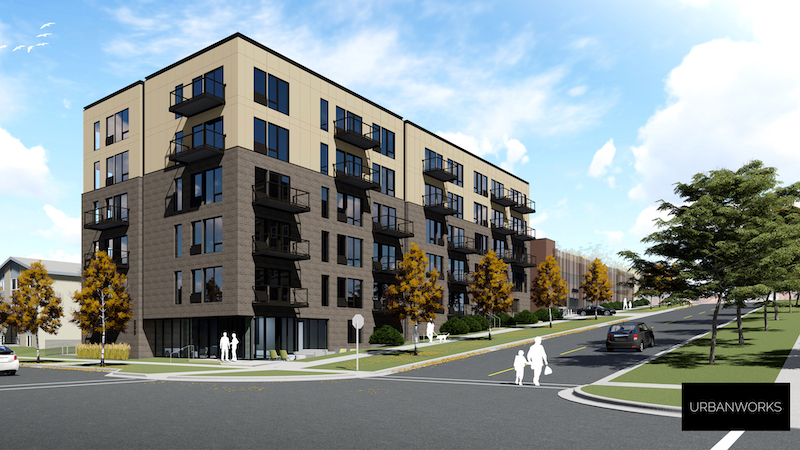
590 Park in St. Paul features 92 upscale micro apartments that target local professionals. Image: UrbanWorks.
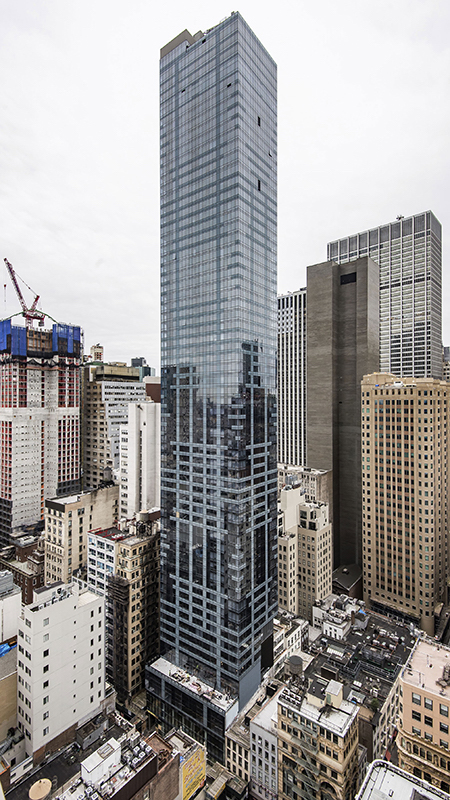
One-fifth of the homes within 19 Dutch, in Manhattan's Financial District, will be affordably priced. Image: Gilbane Building Company
Multifamily continues to address a full range of price options, and higher-end products remain attractive. In St. Paul, Minn., the GC Kraus-Anderson just completed 590 Park, a 57,982-sf building with 92 upscale micro apartments—ranging from 352 to 602 sf—designed specifically for professionals. The $20 million, six-story building—owned by Engelsma Limited Partnership and designed by UrbanWorks Architecture—is near the State Capitol, Regions Hospital, and the Green Line stop at Capitol/Rise Street Station, which provides connectivity to Minneapolis.
However, it also appears that more of what’s being developed, designed, and built targets tenants and buyers seeking affordability.
Among Gilbane’s recent multifamily projects has been 19 Dutch, a 66-story residential tower in Manhattan’s Financial District. Developed by Carmel Partners and designed jointly by Gerner Kronick + Valcarcel and SLCE Architects, the 770-ft-tall tower, which was completed last year, includes 483 furnished apartments, 97 of them affordable. The project also features two floors of retail space and three amenity levels. A rooftop terrace on the 63rd floor is accessible through an adjoining indoor lounge.
“Metrocentric markets make a lot of economic and environmental sense,” says Gagnier, “so we believe there will continue to be demand for multifamily housing—especially affordable housing—in cities and their surrounding areas.” Gilbane anticipates more developer interest in reconfiguring apartment layouts to accommodate home offices.
Summit Contracting still builds “a good bit” on the luxury end of the multifamily spectrum. “But we do see more of a push toward the mid-grade and affordable product,” says Padgett. Summit saw this trend coming a few years ago, and responded with its Summit Prototype Program, which leverages Summit’s buying power and vendor relationships, allowing buildings to be pre-priced and upgraded or downgraded depending on a developer’s budget and desired level of finishes. This program can offset rising land and labor prices and still come in 5-10% lower than a custom-designed project, says Padgett.
Related Stories
| Dec 17, 2010
Luxury condos built for privacy
A new luxury condominium tower in Los Angeles, The Carlyle has 24 floors with 78 units. Each of the four units on each floor has a private elevator foyer. The top three floors house six 5,000-sf penthouses that offer residents both indoor and outdoor living space. KMD Architects designed the 310,000-sf structure, and Elad Properties was project developer.
| Dec 17, 2010
Vietnam business center will combine office and residential space
The 300,000-sm VietinBank Business Center in Hanoi, Vietnam, designed by Foster + Partners, will have two commercial towers: the first, a 68-story, 362-meter office tower for the international headquarters of VietinBank; the second, a five-star hotel, spa, and serviced apartments. A seven-story podium with conference facilities, retail space, restaurants, and rooftop garden will connect the two towers. Eco-friendly features include using recycled heat from the center’s power plant to provide hot water, and installing water features and plants to improve indoor air quality. Turner Construction Co. is the general contractor.
| Dec 17, 2010
Toronto church converted for condos and shopping
Reserve Properties is transforming a 20th-century church into Bellefair Kew Beach Residences, a residential/retail complex in The Beach neighborhood of Toronto. Local architecture firm RAWdesign adapted the late Gothic-style church into a five-story condominium with 23 one- and two-bedroom units, including two-story penthouse suites. Six three-story townhouses also will be incorporated. The project will afford residents views of nearby Kew Gardens and Lake Ontario. One façade of the church was updated for retail shops.
| Dec 7, 2010
Prospects for multifamily sector improve greatly
The multifamily sector is showing signs of a real recovery, with nearly 22,000 new apartment units delivered to the market. Net absorption in the third quarter surged by 94,000 units, dropping the national vacancy rate from 7.8% to 7.1%, one of the largest quarterly drops on record, and rents increased for the second quarter in a row.
| Nov 3, 2010
Senior housing will be affordable, sustainable
Horizons at Morgan Hill, a 49-unit affordable senior housing community in Morgan Hill, Calif., was designed by KTGY Group and developed by Urban Housing Communities. The $21.2 million, three-story building will offer 36 one-bed/bath units (773 sf) and 13 two-bed/bath units (1,025 sf) on a 2.6-acre site.
| Nov 3, 2010
Rotating atriums give Riyadh’s first Hilton an unusual twist
Goettsch Partners, in collaboration with Omrania & Associates (architect of record) and David Wrenn Interiors (interior designer), is serving as design architect for the five-star, 900-key Hilton Riyadh.
| Nov 1, 2010
Sustainable, mixed-income housing to revitalize community
The $41 million Arlington Grove mixed-use development in St. Louis is viewed as a major step in revitalizing the community. Developed by McCormack Baron Salazar with KAI Design & Build (architect, MEP, GC), the project will add 112 new and renovated mixed-income rental units (market rate, low-income, and public housing) totaling 162,000 sf, plus 5,000 sf of commercial/retail space.
| Nov 1, 2010
Vancouver’s former Olympic Village shoots for Gold
The first tenants of the Millennium Water development in Vancouver, B.C., were Olympic athletes competing in the 2010 Winter Games. Now the former Olympic Village, located on a 17-acre brownfield site, is being transformed into a residential neighborhood targeting LEED ND Gold. The buildings are expected to consume 30-70% less energy than comparable structures.
| Oct 13, 2010
Apartment complex will offer affordable green housing
Urban Housing Communities, KTGY Group, and the City of Big Bear Lake (Calif.) Improvement Agency are collaborating on The Crossings at Big Bear Lake, the first apartment complex in the city to offer residents affordable, eco-friendly homes. KTGY designed 28 two-bedroom, two-story townhomes and 14 three-bedroom, single-story flats, averaging 1,100 sf each.
| Oct 13, 2010
Residences bring students, faculty together in the Middle East
A new residence complex is in design for United Arab Emirates University in Al Ain, UAE, near Abu Dhabi. Plans for the 120-acre mixed-use development include 710 clustered townhomes and apartments for students and faculty and common areas for community activities.


